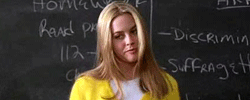Reviews
Mark Waters
USA , 2004
Credits
Review by Chiranjit Goswami
Posted on 03 July 2006
Source Paramount DVD
Categories Chick Flicks
It seems that every generation has its a female-centric high-school comedy that gains a devoted following. Arguably one of the darkest examples of this is Michael Lehmann’s 1989 feature Heathers, which seems to have become embraced wholeheartedly by Generation X as their decisive representation of high school torment. Six years later, Fast Times at Ridgemont High director Amy Heckerling came out with Clueless, a vibrantly bright comedy that affectionately ridiculed opulent but oblivious high-school belles residing in Beverly Hills and almost served as an antithesis to its precursor. Though their methods were drastically different, the success of both films relied heavily upon the ease by which they catalogued, critiqued and cackled at the social caste system that seems to have entrenched itself so deeply into adolescent society.
Though the marketplace has since become flooded with teen-targeted tales, fifteen years after Veronica Sawyer coordinated her wardrobe to croquette and nearly a decade after Cher Horowitz guided us through her Noxzema-commercial life, Saturday Night Live head-writer Tina Fey decided to renovate the genre for Generation Y after having read Rosalind Wiseman’s non-fiction work Queen Bees and Wannabes. Enlisting the help of House of Yes director Mark Waters, who happens to be the younger brother of Heathers scribe Daniel Waters, the final result was Mean Girls, a film that feels very much like the younger sister to Heathers and Clueless. Understandably, younger sisters are often relegated to subsist in the shadows of their older siblings, but it’s rather regrettable that Mean Girls is unfairly dismissed as being inferior to its predecessors, especially since it could be viewed to be a more mature film in certain aspects.
Mean Girls centers on Cady Heron, an intelligent but innocent American teen who is gifted at math and has lived abroad most of her life because her zoologist parents have been conducting research in Africa for the past twelve years. Consequently, Cady has been home-schooled and has not had to experience the American scholastic environment. However, when Cady’s mother receives tenure at Northwestern University, the family moves to Illinois and her parents decide she should attend a normal public high-school named North Shore so that she can “socialized.” Sadly, socialization proves to be difficult, as Cady’s first day turns into a disaster as she wanders through this unfamiliar world. Fortunately, she soon latches onto a couple of outsider “art-freaks” named Janis and Damian, who help her navigate through these rough waters and provide her guidance regarding the established social-class system amongst the North Shore juniors.
At the center of this adolescent ecosystem are the Plastics, a trio of popular privileged girls led by the authoritative Regina George, who set the female standards for fashion, music, and behaviour at North Shore and are the envy of their peers. Motivated by a past personal feud, Janis encourages Cady to infiltrate the Plastics in order to damage their social status and fracture the group. Unfortunately, at the cost of her own identity and accomplishments, Cady becomes just as infatuated with Regina and her minions as any other student and soon seeks to fortify her own growing social status. We soon witness a ceaseless cycle of malicious behaviour, as the various players within North Shore’s “Girls World” attempt to victimize one another through seemingly endlessly cruelty.
Produced by Saturday Night Live creator Lorne Michaels, starring the ubiquitous Lindsay Lohan as the charming Cady Heron, featuring rising star Rachel McAdams as the venomous Regina George, and littered with current and former SNL cast members, it’s undeniable that Mean Girls is very much a Hollywood movie. Though imitating the MTV-inspired visual design that has become standard in the genre, the colours in Mean Girls are slightly demure in comparison to the brightly-coloured sparkle of Clueless, and they are drastically different from the drearily dim atmosphere in Heathers, in which any semblance of colour appears downright gaudy and harsh, underlining the film’s dark, satirical outlook and its rendering of high school as a warped, caustic, hazy nightmare. However, Fey avoids creating pure confection, making certain that adolescent female behaviour is provided a reasonably accurate portrait by including a range of deceitful and malicious behaviour that feels authentic no matter how glossy the film appears.
Learning from the previous success of its siblings, Mean Girls amalgamates the best qualities of these films, but remains distinctive by avoiding much of the vicarious delight provided by its predecessors. Unlike the alluring lifestyle presented during Clueless’ critique of the upper-class, or the revenge fantasies excused as embellishment in Heathers’ absurd satire, Mean Girls grounds itself in modest filmmaking, rarely exaggerating its setting and seldom diverging into the abstract imagery. Whereas Cher reaches her epiphany while shopping in Clueless, and Veronica wages war with her boyfriend in the boiler-room in Heathers, Mean Girls simply allows Cady to realizes her mistakes while glancing at a hopelessly geeky girl that she must compete against. Instead of bizarre satire or an envious gaze, the more realistic (though somewhat amplified) techniques in Mean Girls makes it difficult for the audience to distance themselves from the vicious conduct being exhibited, especially since it’s delivered through a form they have grown accustomed towards accepting as customary.
Instead, director Mark Waters carefully mixes in his stylistic flourishes in a comfortable manner. To convey the extent of Cady’s isolation, whenever she retreats from the alienating cafeteria to eat lunch alone in a washroom stall, Waters traps Cady by dissolving through the door and blocking off the sides of his frame using the walls, effectively creating a sense of figurative solitary confinement. Later, Waters presents a multiple-line phone conversation in a mildly novel manner, adeptly employing split-screen to simultaneously emphasize both the concealed connection and unspoken division amongst the clique. Waters also understands the power of group dynamics within high school and frames his characters accordingly based upon their fluctuating social status. Initially Cady is isolated to close-ups, and Janis and Damian are established together in a two-shot, while the Plastics are assigned a three-shot. Once each group officially accepts Cady into their membership, the framing expands to include her within the respective compositions and unite each group. However, the filmmakers also understand that while cliques seek to maintain a unified front by implementing the same standards in appearance and behaviour, there is a rigid hierarchy in place that creates anxiety within the group. Thus, as group dynamics begin to shift, Waters adjusts his framing accordingly.
Given the film’s uncanny depiction of teenage girl behavior, it is unsurprising that many consider Fey to be the true “auteur” of Mean Girls. In her prominent role as “Weekend Update” co-anchor on “Saturday Night Live,” she regularly mocks both politicians and celebrities, while providing a gently, humorous, subversive female perspective on various sensitive cultural issues. Mean Girls is no different, and its comedy is grounded in the attention to character insecurity and the reality of awkward social interactions. Fey’s screenplay provides a charming combination of soft satire and pop psychology, though she takes adolescence seriously enough not to dismiss it as merely just an inconsequential rite of passage.
Fey also appears troubled by the social-politics that shape the identities of young women and her script demonstrates a comprehension that the primitive high school ecosystem continues to sustain itself by unconsciously enforcing primal rules that ensure the survival of the fittest. To illustrate high school as a Darwinian struggle to survival, Fey fashions a rather blunt yet innovative metaphor of high school as an animal kingdom where civil behaviour is merely a camouflage for predators. Her concept of high school students imitating animals may border on excessive, but it works wonderfully when it reminds us that teenagers occasionally forget their humanity.
As frenzied as her teenager characters eventually become, Fey also seems to understand just how the social order and caste system of high school creates and maintains itself in order to suppress this overly hysterical behaviour. Though not as covert as Heathers’ lunch-time cafeteria poll, Fey promptly catalogues the various cliques that comprise North Shores’ social scene by having Janis sketch a map to help Cady traverse through the school cafeteria. While the scene figuratively facilitates the adaptation of a new species into an unreceptive environment by essentially supplying them a survival guide, what becomes noticeable while we wander through North Shore is that the voluntary social segregation that transpires often occurs along demographic barriers. In fact, in a subtle method, Fey’s script casually confronts the issue of how minorities survive the high school experience by bonding over their similarities to overcome the implicit tensions. We soon realize how race shapes North Shore’s cliques, as Janis’s tour of the cafeteria crowd makes note of the “Asian Nerds”, “Cool Asians”, and “Unfriendly Black Hotties.”
Fey also illustrates how factors such as sexuality and physical differences serve as obstacle to integration. Undoubtedly what ostracizes “art-freaks” Janis and Damian from the majority, and strongly bonds them together, is not only that they love art, but also that they do not conform to the mainstream ideals of sexual identity. Damian, who regularly hangs out in the girls’ washroom, is openly “too gay to function,” and thus appears to be excluded from the male society of North Shore, whether voluntarily or forcefully. Meanwhile, Janis’ banishment from the Plastics, and her hatred towards Regina, is largely a function of Regina’s assumption that Janis is a lesbian, which provided Regina enough ammunition to spread a vicious rumour concerning Janis’ sexual orientation. Finally, Fey also shows that physical disparity provides another means of alienation from the majority, as Janis deems a group that includes physically-handicapped and little-people to be “Hopeless Wannabes.”
Interestingly, the one clique that avoids these tensions is North Shore’s Math Team, which attempts to recruit Cady. The “Mathletes” are comprised of students from various ethnic backgrounds, presumably because math is a universal language that Cady believes is “the same in every country.” Though they are deemed as “social suicide,” the Mathletes appear to disregard their social seclusion. Led by Kevin Gnapoor, an East-Indian hip-hop addict who is ridiculously confident in his divergence from the collective ideal and embraces the characteristics that provide excuse for his exclusion, the Mathletes boldly exhibit there accomplishments via leather team-jackets. It turns out that Kevin is comfortable enough with his distinctive traits that he rejects Cady at the height of her powers and instead decides to charm Janis. By uniting Kevin and Janis as a couple towards the end of the film, Fey signals that the borders between the various cliques have begun to blur or breakdown entirely. We are then given glances of various interracial relationships, as Fey provides the inevitable progression of the ongoing flirtation between Ms. Norbury and Principal Duvall, and we glimpse Gretchen serving a new Korean Queen Bee. Thus, we realize that Fey’s ideal would be a more comfortable atmosphere for honest race relations.
While Fey carefully displays the group dynamics of high school in Mean Girls, she also keenly observes how this environment negatively affects a female’s image of herself. Part of the daily female adolescent dilemma is an incessant struggle with insecurity, probably best exemplified by Gretchen, who only feels confident when serving a queen bee and thus allows Regina to control many aspects of her life without complaint. The Plastics must obtain Regina’s blessing regarding what they wear and who they date, with Gretchen informing Cady that “you may think you like someone, but you could be wrong,” before warning her that “ex-boyfriends are just off-limits to friends. I mean, that’s just the rules of feminism.” In addition, the film includes various scenes detailing how worried young girls become regarding their personal body image. Not only do we pass by the “Girls Who Eat Their Feelings” and the “Girls Who Don’t Eat Anything” in the cafeteria, but even the coveted Plastics dissect the numerous flaws of their bodies.
It is also important to realize that Janis and Damian are also considered to be “mean girls.” It often goes unnoticed that it is Janis and Damian that convince Cady to engage in inappropriate behaviour. They are the first ones to sense Cady’s weakness and trick her into skipping class by offering her their friendship. It is also Janis that constructs the elaborate plan to torture Regina and the Plastics to satisfy her own personal revenge and alleviate some of her personal trauma. Thus, Fey illustrates that being cruel is not behaviour directly tied to social status, but rather may be inherent to the female high school experience. Janis, for instance, lashes out and acts callous towards others because she is insecure about her position with high school society.
However demented all of this insecure behaviour appears, what becomes truly disturbing is the unnecessary conduct that young women engage in when the affection of a male is at stake. In fact, via subtle forms of sabotage, Cady and Regina display truly nasty behaviour towards one another during their battle over North Shore’s resident hunk and prized possession, Aaron Samuels. Aaron’s effect upon Cady is quite visible, as the film drifts into a dreamy slow-motion and adds a swell of string-music whenever Cady gazes upon him. In an effort to attract Aaron, Cady follows her “instincts” by concealing her own intelligence, ignoring the math team’s recruitment efforts, and purposely failing calculus so that Aaron will agree to tutor her. Though it’s frustrating to witness Cady taking advice from an inferior student simply so she can attract his attention, exhibiting academic ability sadly seems to be collectively frowned upon in “Girl World.” In fact, displaying one’s intelligence seems utterly foreign to the Plastics, as the trio look upon Cady with puzzled expressions while she solves a simple real-world math equation involving nutrition. Luckily, via encouragement from Ms. Norbury, Cady finally figures out that she no longer needs to hide her natural talents and embraces her abilities. In fact, during a crucial moment, Cady treats Aaron as a distraction that she must disregard so that she may remember a proof taught during math class. Having answered the question correctly, Cady proudly strides into her Spring Formal comfortably wearing her Mathletes team jacket after having won the state championship.
Finally, one of Fey’s most notable accomplishments with Mean Girls may be her suggestion that the obsession with high school popularity provides the basis for the adult fascination with celebrity culture. Certainly Fey and Waters construct Mean Girls to have the Plastics viewed as the celebrities of North Shore. Early on, Damian refers to the trio as “teen royalty” and states that “if North Shore was US Weekly, [the Plastics] would always be on the cover.” Unfortunately this accomplishment may simultaneously serve as both shrewd analysis and prophetic vision. It is important to note that as much as Cady’s ascension in the ranks of the Plastics signals her arrival at North Shore, it is also the success of Mean Girls that signals the arrival of Lohan as a bankable movie star.
Alas, in the two years since the release of Mean Girls, it’s become increasingly difficult to distinguish Lohan’s personal life from her role as Cady. Whether this perspective has been fabricated by gossip columnists or represents a distressing instance of life imitating art is a debatable topic, but since 2004 the hype surrounding Lohan has been palpable. Indeed, the Hollywood publicity machine has created a massive amount of negative press for the young actress as she has moved rapidly from trendy ingénue to tacky tabloid fodder. While the financial success of Lohan’s subsequent films since Mean Girls has diminished greatly, the actress has become infamous for her family troubles, her alarming weight-loss, her conceited conduct, and her constant bickering and public feuds with fellow young “actresses” such as Hilary Duff. Given that such events are broadcast so frequently, it’s uncanny how the various issues and events within Mean Girls have materialized in Lohan’s life, to the point that it’s hard not to immediately identify Lohan as Cady, or perceive Tina Fey as Ms. Norbury attempting to provide Lohan with guidance, while we recognize someone like Paris Hilton as Regina. Regrettably, Fey’s efforts seem to have fallen victim to the very same cultural infatuation with celebrity that she openly criticizes. Hence, Mean Girls’ most lasting effect may be measured in how it influences our collectively view of its star, which is a shame considering that the film is among the most marvellously mature, witty, and refreshing dissections of the modern high school experience.
More Chick Flicks
-

The Truth About Cats & Dogs
1996 -

Say Anything
1989 -

Gas Food Lodging
1992 -

Pretty Woman
1990 -

Walking and Talking
1996 -

Mean Girls
2004 -

Fried Green Tomatoes
1991 -

Private Benjamin
1980 -

Clueless
1995 -

Erin Brockovich
2000 -

The Bridges of Madison County
1995 -

Bridget Jones’s Diary
2001 -

Working Girl
1988 -

Bend It Like Beckham
2002 -

Bring It On
2000 -

Ghost
1990 -

Truly Madly Deeply
1991 -

The Last of the Mohicans
1992
We don’t do comments anymore, but you may contact us here or find us on Twitter or Facebook.



